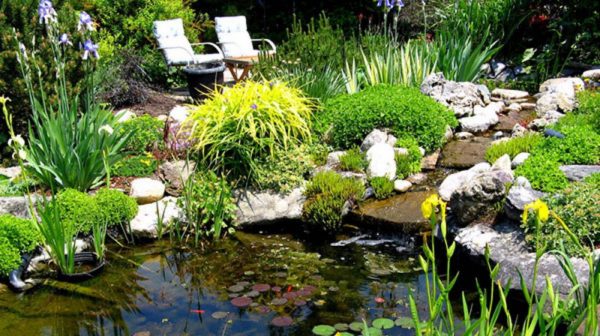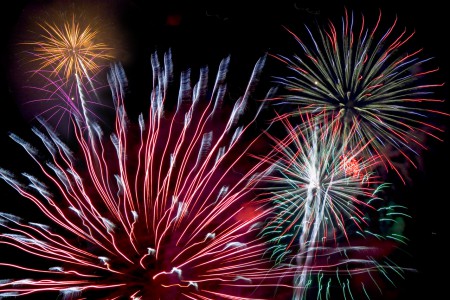
Wondering how to winterize a pond or water feature? We’ve got the answers for you, divided into advice on fish, plants, water, and equipment, so you can get that valuable addition to your landscape ready for a safe, healthy winter season! These practical tips will also allow you to get a jump start in the spring with fewer fish and plant losses, and a strong, healthy ecosystem for another three seasons of enjoyment. When you winterize your pond or water feature, you save money, time, and protect your aquatic investment!
Overwintering Fish
When water temp reaches 70 degrees Fahrenheit or below, switch to an easily digestible fish food, many pond experts recommend a wheat germ based food. Allow your fish to guide your feeding schedule, feeding no more than they can eat in 5 minutes, and begin slowing down the feedings as they get sluggish. Stop feeding when water temperature hits 40F and do not feed again until winter is over and water temperature stays above 40F for the season. Feeding while fish are dormant causes waste build up which can kill your fish.
Larger, deeper ponds with areas at least 2 feet deep that don’t freeze solid will allow fish to overwinter safely in Central Ohio. Small or shallow water features that will freeze solid in the winter aren’t safe for your fish, so they should be removed to an indoor tank. Indoor tanks will ideally be filled with your own pond water and include a pump and filter, and should stay between 50F and 60 F to allow fish to stay sluggish, but not dormant. You can use your pond/water feature filter in your tank if you like, which allows you to keep the beneficial bacteria alive and working. Move fish when pond water and tank water are similar temperatures to avoid shocking the fish. Feed once a week, and don’t allow uneaten food to stay in the tank. Check water quality and do 50% water changes as needed to maintain healthy fish.
Check with your local aquarium store if you have unusual or fancy breeds of fish. Most will recommend that fancy goldfish or more delicate breeds overwinter INDOORS, not outdoors, no matter how deep your pond.
If you plan any beneficial bacteria additives or fish medication, treat the pond while water temperature is 50F or warmer. Pond salt isn’t recommended, as it’s only removed by water changes and can damage your plants.
Overwintering Plants
Remove all dead or dying plant material from the pond on a regular basis. Just as the trees begin to change color, stretch a fine net on a PVC pipe frame above the surface of your pond in a tent shape or use an automatic skimmer (check and empty daily) to capture autumn leaves as they fall and before they can begin to decompose and use up the oxygen in your pond water. Remove netting at the first snowfall, or it may freeze into the edges of your pond. Handheld nets are not recommended for all of your leaf removal, as they aren’t effective enough.
Divide and repot any plants that have grown out of their current containers. When the air temperature gets to 65F during the day, move tropical plants indoors for the season. Trim taller plants back to reduce dead leaves overwintering in your pond, and pull lilies and bog plants out, trim surface foliage, and return to the deepest area of your pond. If your pond or water feature freezes solid over the winter, remove plants to an indoor location and store in plastic bags. No sunlight is needed. Check weekly to ensure the plants remain wet, adding water if needed.
Plants with hollow canes such as rushes should be left whole until spring. The hollow core can allow water and bacteria down into the heart of the plant, causing rot.
Water
Use a fine mesh strainer to remove excess silt and dead plant material from the floor of your pond in the beginning of the fall. Preferably while water temperatures are still warm enough for your comfort while wading. If the water is looking particularly murky, or ammonia or nitrate levels are high, you can use a small pump or a garden hose/gravity to drain some of the water out and replace with fresh water. Don’t forget to use a de-chlorinator if you use tap water instead of well or rain-barrel water.
Equipment
As water reaches 40F, turn off waterfalls and remove pumps, UV, and filters, cleaning thoroughly. Follow manufacturer’s instructions, most plastic pumps should be stored indoors, in water that will not freeze to protect seals from dry rot. Stainless steel pumps should be stored indoors, dry. UV units should be drained, cleaned with a bleach solution, rinsed well, and stored dry. Filter pads can be stored dry after thorough cleaning. Do not return pumps or filters to the pond until spring, as constant water flow can actually cause fish to use their stored energy and die. Underwater lighting can stay in the pond year round, although fall is a great time to check, clean, and re-seat it. Winter ice looks beautiful when lit from below!
Smaller water features that are above ground, such as fountains, waterfalls, and mini-ponds should be emptied, cleaned, and stored indoors according to manufacturer’s instructions. If left outside, the water inside can freeze, expand, and split containers, tubing, pumps, and filter boxes.
Do you need a de-icer? A large pond deep enough not to freeze solid during winter keeps your fish and plants safe most years, but you may want to invest in a de-icer to keep a small amount of open water for off-gassing and oxygenation. Check the de-icer daily for deposits, and even if it seems clean, wipe every two weeks with vinegar. Deposits of dirt, lime, or fish waste can cause the heating element to overheat and burst, posing a risk of electrocution to your fish and to you!
Check with your local pond and fish experts for information specific to your fish, plants and equipment.





